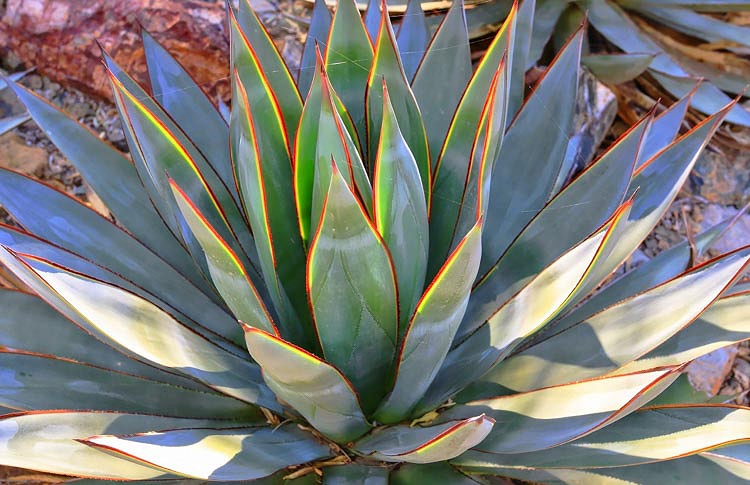This variety of succulent is a slow-growing perennial. It is a hybrid plant that gets its broad leaves and vibrant green coloring from Agave Attenuata, while its sharp terminal spine and small, compact size come from Agave Ocahui.
Agave Blue Glow grows its best when set in a partially shaded area that protects it from extreme amounts of sunlight. It should be planted in soil that is slightly acidic, sandy, and well-drained.
While this succulent variety is very hardy and can handle drought and heat once established, it cannot tolerate frost or cold, wintry weather.
This is the perfect plant for an outdoor area in Mediterranean and arid climates. It also suits indoor living well when it is given plenty of heat and sunlight. These plants are virtually disease-free and are deer resistant. They do, however, attract slugs and snails.
How to Identify Agave Blue Glow
There are so many types of agave plants, so how can you be sure that the plant you are growing is an Agave Blue Glow? This is a hybrid of Agave Attenuata and Agave Ocahui and it is pulling the best of those two types of agave plants. Here are the distinguishing features of this particular agave plant.
Leaves
The most pronounced features of Agave Blue Glow are the red and yellow colors that line its soft, spineless leaves. The leaves are also broad just like its parent plant, Agave Attenuata.
Size
Agave Blue Glow is a more compact agave plant. This is a characteristic that it gained from its other parent plant, Agave Ocahui. In fact, Blue Glow only grows up to 2 feet tall and three feet wide which is quite a bit smaller than the possible 3 feet in both directions that Agave Ocahui can grow.
Where Does Agave Blue Glow Grow
This hybrid was developed in California. It is best grown in warm, arid climates such as Southern California, Arizona, and New Mexico. Basically, this plant thrives in US Hardiness Zones 9a to 11b.
Uses of Agave Blue Glow
These plants are perfect to use in rock gardens, cactus gardens, or desert gardens. They make great indoor decorations or accents along an outdoor walkway.
How to Grow Agave Blue Glow from Seed
Since these plants are monocarpic, it would seem like they would easily grow from seeds; however, they are also hybrids that rarely flower. Because they are hybrids the seeds that the flowers produce may not be true Agave Blue Glow plants. And because they rarely flower, it may be very difficult and time-consuming trying to gather seeds to propagate the plant. The best way to propagate an Agave Blue Glow is through coring.
Agave Blue Glow Growing Conditions
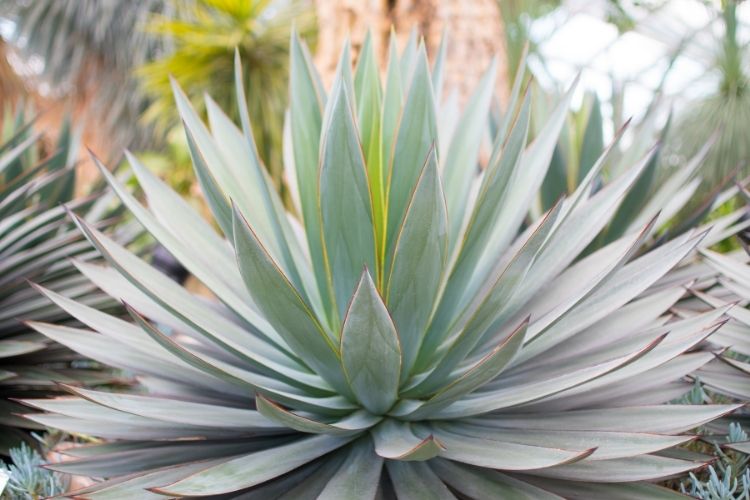
These plants are very hardy and can deal with extreme heat and sunlight when they are well established. To get them to that point, though, does take a little research and effort. Let’s walk through the steps of how to care for this type of succulent.
Prepare Their Home Turf
Since these succulents are not easy to transplant, decide where in your yard or home they will get the best chance to thrive. If you plan to plant them in your yard, be sure they are in a place that has filtered sunlight and well-draining soil.
Also, consider which plant growing zone you live in. If you don’t live in USDA hardiness zones 9a to 11b, you may need to keep your Agave Blue Glow plants in containers that can be moved indoors during certain times of the year.
Let Them Be
Agave Blue Glow plants can take care of themselves. Once they are established, neglecting them is something you can do without feeling like a bad caretaker; in fact, they prefer that you let them be.
If they begin to look sickly, then check to see if they need a drink or some nutrients, or if they have an insect infestation. Otherwise, they should be just fine left alone most of the time.
When to Plant Agave Blue Glow
Agave plants are kept in containers where the pot can become full of roots. When this happens, it is time to re-pot the plant. Repotting an Agave Blue Glow is as simple as selecting a new, bigger pot, filling the pot with potting soil, and placing the plant in the soil.
How to Plant Agave Blue Glow
Newly planted agaves should be watered frequently, but eventually, this can be cut back to about every other week. Agave Blue Glow plants should be planted in a spot that will get at least 6 hours of sunlight each day and will not get cold in the winter.
If the plant is kept indoors, it will need to be in a sunny window, preferably one that is facing the South. If kept outdoors, it will need to live in a climate that does not get colder than 20 degrees Fahrenheit.
Agave Blue Glow Water Requirements
Overwatering succulents can cause them to rot. It is very important to learn how to water Agave Blue Glow properly so they don’t rot from overwatering and they don’t dry out from underwatering.
The best way to know when to water your Agave Blue is to test the top layer of soil surrounding its base. If the soil is wet, wait to water it. If, however, the soil is dry, wet the soil and allow it to drain thoroughly.
Agave Blue Glow Sun Requirements
These plants prefer partial to full sun. They will need at least 6 hours of bright sun each day to thrive. Of course, young plants or plants that are being brought outside after winter will need to acclimate to full sun or they will get sunburnt.
Acclimatization is a simple process of allowing the plant to get used to sitting in direct sunlight. Let the plant sunbathe for a few hours the first day, then slowly add some time each day until it the plant is in the sun for the fullest amount of time it can handle. In the case of Agave Blue Glow, it can hand six hours of full sun once it is established.
Best Agave Blue Glow Fertilizer
While these particular plants don’t need fertilizer, giving them a little during the summer can boost their health. Simply use a fertilizer made for cacti and succulents or try some earthworm humus or fish emulsion. Another great way to feed your agave plant is by giving it a little homemade compost.
One very important thing to remember about fertilizing an Agave Blue Glow plant is that it should only be fertilized during its growing season in spring and summer. Once cooler weather comes along, fertilizing an agave can actually harm it.
Best Agave Blue Glow Companion Plantings
There are other types of succulents that look similar to the Agave Blue Glow that could be used as a complementary neighbor to an Agave Blue Glow or as an alternative. Here are some of the best companion plants to consider.
Agave Americana
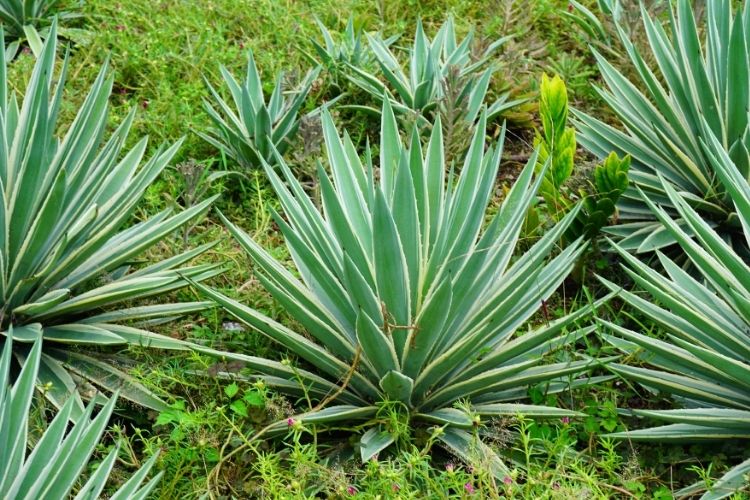
This plant is a huge perennial succulent that features long spiny-edged leaves. It is a very popular plant for lovers of cacti and succulents and should look familiar to most people.
While it is easy to care for variety and very hardy, it does have a few features that may cause some gardeners to opt out of including them in their yard.
Pros
- Tolerates light shade better than most other agave plants
- Tolerates heat and drought very well
- Attracts hummingbirds
- Resists deer
- Virtually free of disease
Cons
- Contains sharp spiny leaves that can injure humans and pets
- Can grow up to six feet tall and ten feet wide
- Its sap is poisonous and can cause irritation to the skin if touched and digestive issues if swallowed
Agave Cream Spike
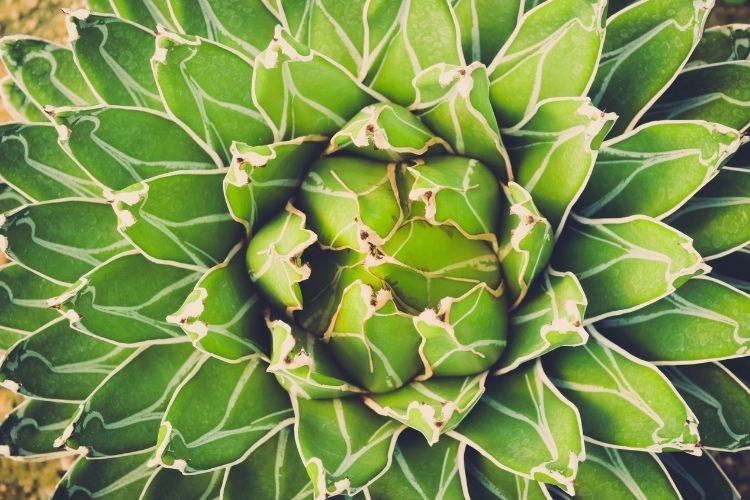
This variety of agave plants is more compact than others. It is also a succulent that enjoys being alone. There are many wonderful reasons to include the Agave Cream Spike in a garden, but there are negatives that must be considered.
Pros
- Only grows up to four inches tall and six inches wide
- Can be planted, pulled up, and then, replanted easily
- Is an ideal plant to place in containers
- Tolerates part shade
- Tolerates drought and full sun
- Virtually free of disease
- No toxic effects have been reported with this variety
- Resists deer
Cons
- Contains spikes along the edges of its many leaves
- Is susceptible to attacks by slugs and snails
- Does not tolerate frost
Agave Blue Flame
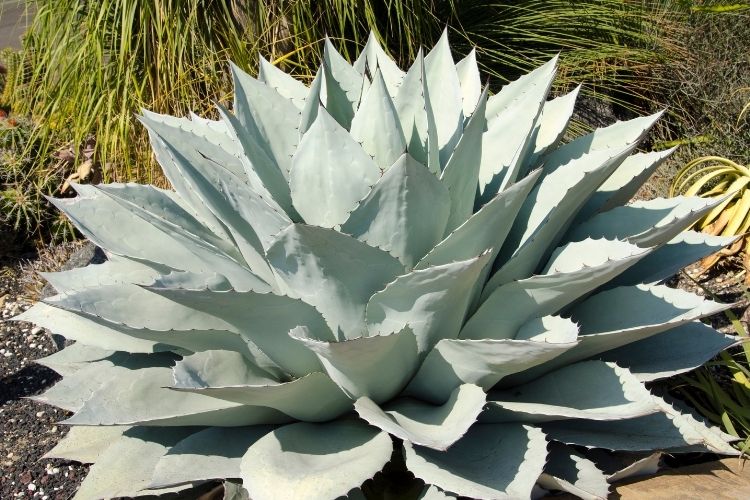
This is a perennial hybrid agave that features blue-green leaves formed into an exquisite-looking rosette. It is the perfect type of agave to create a dramatic focal point in a garden design. The key features of the Agave Blue Flame are its hardiness, its cool-green color, and its elegant form.
Pros
- Tolerates drought
- Tolerates part shade
- Can be planted in a garden plot or in a container
- Resists deer
- Virtually free of disease
Cons
- Rarely flowers
- Can grow up to three feet tall and four feet wide
- Attracts slugs and snails
- Does not tolerate frost
- Should be brought inside during the winter months
- Is mildly toxic
Agave Blue Glow plants look great with nearly every other type of succulent. This is because they can be the center of attention or just a side accent in landscaping projects. If you’re looking for some friendly neighbors for your outdoor agave plants, here are a few recommendations.
Crassula Plants
Looking for other plants that grow well in the same hardiness zone as the Agave Blue Glow? These are zones 9a to 11b. This mostly includes other succulents and some cacti, but these make for some of the loveliest landscapes.
Crassula plants have a deep dark green color with cute little leaves that will surely balance out the agave plant’s lighter green color and long, tough leaves. Also, these plants require similar care as the Agave Blue Glow. This will streamline caring for both plants.
Kangaroo Paw
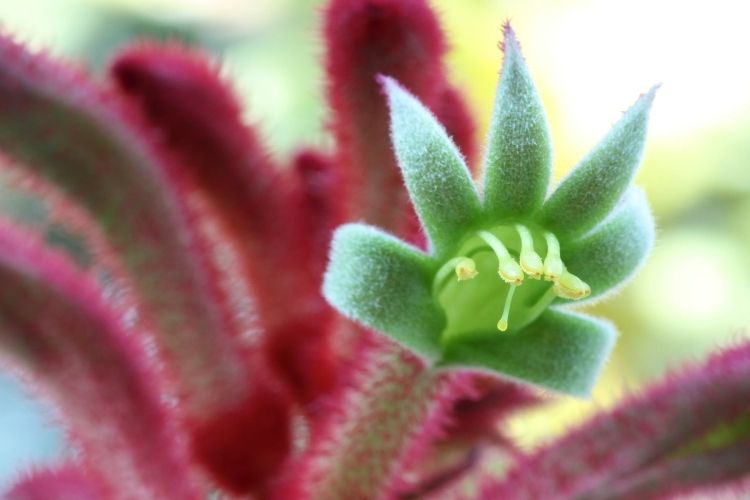
Give your garden a splash of color. Look for some plants that will complement the green shade of your Agave Blue Glow. There’s no need to look for something that is both brightly colored and adapted to the same growing zones. This is your chance to mix things up every Spring.
These are lovely and delicately looking plants with vibrant shades of red, orange, pink, purple, or yellow. With these placed alongside your Agave Blue Glow, your garden is sure to be charming.
Not only will these look good next to your agave plants, but they also need full sun and well-drained water, just like agave plants. Kangaroo Paw is going to be the perfect partner.
Agave Blue Glow Diseases and Common Problems
Agaves are hardy plants, but they are still susceptible to infestations and disease. Let’s look at what to do if you think your plant is struggling because of a disease or infestation.
To find out if your agave has been infested look for damaged tissue in the place where the leaves meet the stem. If you see that the lowest leaves are wilted, you may have an infestation.
Check for further proof by trying to rock the plant. If it moves back-and-forth easily and doesn’t feel anchored by its roots, you definitely have a problem.
Agave Blue Glow Treatments and Maintenance
If your agave is infested, there are a few things you need to do in order to save it before it is too late.
- Treat your agave early: the sooner you get to it, the better chance it has of surviving. This is why you should regularly check for pest infestations.
- Use an insecticide: spray the agave that is infested with an insecticide that includes imidacloprid. This should be done in early April and late May, but only if the plant is not about to bloom.
- Take preventive measures: You can prevent an infestation of your agave plants by taking preventive measures. These include:
- Checking all new agave plants for infestation before planting them
- Removing all infested and unsavable agave plants from your garden area
- Applying a systemic insecticide before an infestation has a chance to grow
Agave Blue Glow Repotting Instructions
- When repotting one of these plants, you will need to do the following:
- Select a container that will hold the plant
- Fill the container two-thirds full with potting soil made for succulents and cacti
- Place the plant into the potting soil
- Fill the remainder of the container with potting soil
- Give the plant a drink
- Care for the plant as you would any other agave
Where to Buy Agave Blue Glow Seed Online
Remember that this particular agave plant is a hybrid and propagating it by seed is difficult. But, if you choose to take this route, you can try to purchase seeds at Seed Savers Exchange.
Where to Buy Agave Blue Glow Plants Online
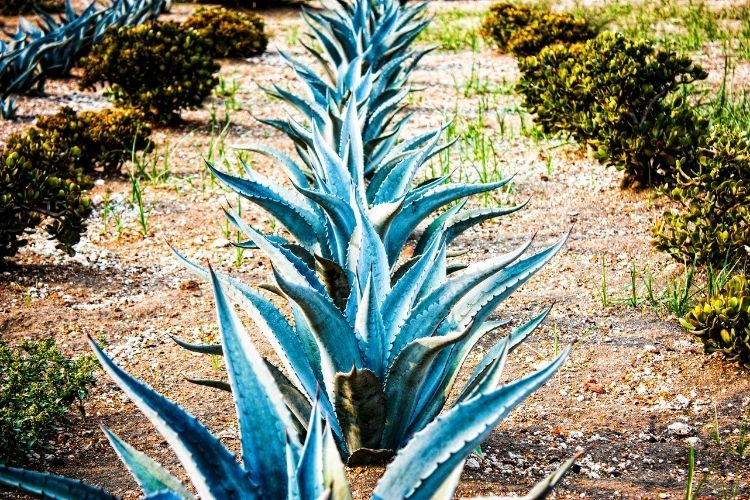
There are many online stores that can supply the succulents you want, but if you are looking for some reputable places to purchase a plant online, try one of these shops.
FAQs
Question: Are Agave Blue Glow Plants Self-Propagating?
Answer: No, they are not. This variety of agave will not reproduce itself through pups, and because it is a hybrid, its seeds may not produce a true offspring.
Once your Agave Blue Glow blooms and dies, you will need to pull it up and replace it with another plant. It should be many years before this necessary, so you will get many growing seasons of enjoyment from this plant.
Question: Do Indoor or Potted Agave Blue Glow Plants Require Different Care Techniques?
Answer: Yes, agave plants grown in pots or containers will require a different sort of care than those that are planted in an outdoor garden space. Most agave plants that are placed in pots have been planted this way because the climate would not allow the agave to survive outside all year around.
Because of this, there are a few preparations that must be made in order to ensure that the agave plant will thrive.
– Select an area where the agave is sure to get partial to full sun. Whether the agave plant is outside for the summer months or resting inside during the winter, it will need plenty of sunshine to be healthy. Be sure that it is placed in a spot that offers it the best sun of the day.
– Bring the agave plant indoors when temperatures dip below 25 degrees Fahrenheit. These succulents do tolerate a little chill, but not anything more than this.
– Potted agave plants should not be overwatered since this can cause them to rot. Before watering them, check the soil to make sure it is dry. If it is dry, give the soil a soak and let it drain.
– Soil is very important for potted agave plants. Give them slightly acidic, sandy, or coarse soil.
Concluding Thoughts
Agave plants are one of the easiest types of plants to grow and care for. They are also beautiful plants to include in outdoor landscapes and indoor décor.
The Agave Blue Glow is the perfect hybrid plant for anyone who is trying out gardening for the first time or those who are already knowledgeable and proficient gardeners. Whichever type of gardener you are, you can be certain that keeping one of these plants will be a pleasure.
Research Citations
If you want to learn more tips about how to take care of your succulents, cactus or plants, check the links below:
- Stapelia Gigantea (Zulu Giant): Plant Care Guide For Beginners
- Senecio Vitalis (Narrow-Leaf Chalksticks): Care and Growth Guide
- Cephalocereus Senilis (Old Man Cactus) How To Grow and Care 101
- Agave Parryi (Artichoke Agave): How To Grow Them Fast And Healthy
- Lophocereus Marginatus (Mexican Fence Post Cactus) - January 10, 2022
- Best Cactus Fertilizer Guide - January 9, 2022
- Selenicereus Grandiflorus (Queen of the Night) - January 3, 2022

